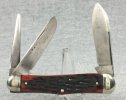- Joined
- Dec 11, 2012
- Messages
- 2,149
This pattern closely echos a black box Winchester 3 spring knife. I’m wonder if that was the inspiration.
The BladeForums.com 2024 Traditional Knife is available! Price is $250 ea (shipped within CONUS).
Order here: https://www.bladeforums.com/help/2024-traditional/
I am predicting that there will be NO scrambling on these. It seems that would make sense to have a larger ramfoot on this 29.Bring it on! Osage or Tidioute bone would be my choice.
If I can just go online and buy one, I'll be very pleased. I hope there'll be no lolly-scrambling - I just don't have the time or energy for that.
Misprint? I assume the ram/lamb picture is in reference to the #93 that just came out. Maybe the sheepfoot on the #29 will be a larger ramfoot.
I think you're both spot on. There was also an older 3 spring Henry Sears that may have been an influence on the Winchester and now the 29. I believe it had a spear main with spey and punch secondaries.Colin, I'm pretty sure you are correct, as Bill was at Queen when those were made, and the two patterns are almost identical, even down to the three springs. The Winchester black box was #3904, and had spey and pen secondaries with a clip main.

I like the sound of a new coffeehouse acrylic.
Colin, I'm pretty sure you are correct, as Bill was at Queen when those were made, and the two patterns are almost identical, even down to the three springs. The Winchester black box was #3904, and had spey and pen secondaries with a clip main.
I think you're both spot on. There was also an older 3 spring Henry Sears that may have been an influence on the Winchester and now the 29. I believe it had a spear main with spey and punch secondaries.
Edit:
Found a photo of the Henry Sears. Not my knife nor my photo.
View attachment 1149041
I wish this was a Whittler configuration, or at least on two springs, but I still want one even with the three springs.
I thought this was going to be a splitback?
This pattern closely echos a black box Winchester 3 spring knife. I’m wonder if that was the inspiration.
Colin, I'm pretty sure you are correct, as Bill was at Queen when those were made, and the two patterns are almost identical, even down to the three springs. The Winchester black box was #3904, and had spey and pen secondaries with a clip main.
Agreed. Three springs will make it a bit of a brick.
Yes. Now to choose if I want an osage or jigged bone brick.Agreed. Three springs will make it a bit of a brick.
